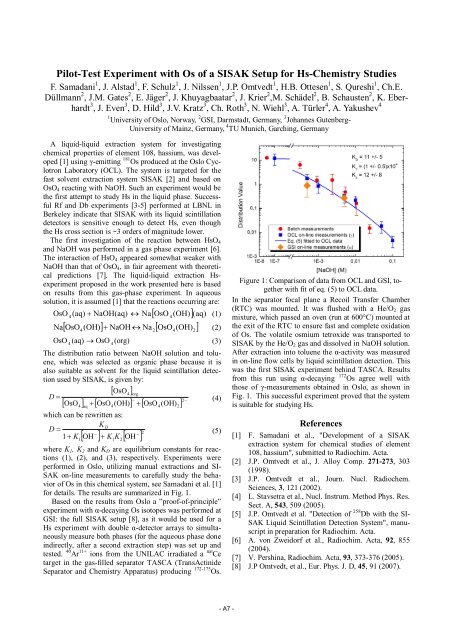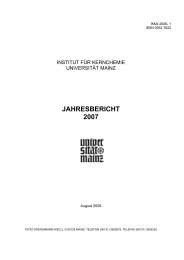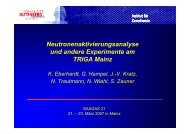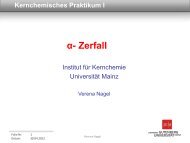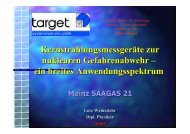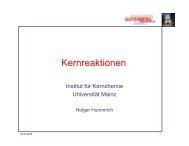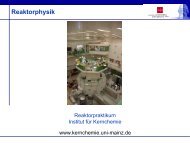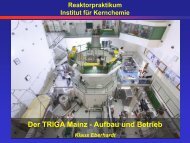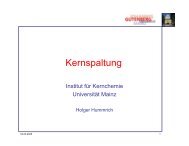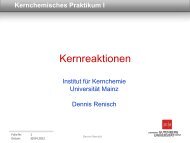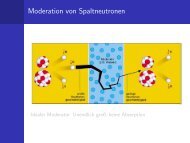institut für kernchemie universität mainz jahresbericht 2009
institut für kernchemie universität mainz jahresbericht 2009
institut für kernchemie universität mainz jahresbericht 2009
You also want an ePaper? Increase the reach of your titles
YUMPU automatically turns print PDFs into web optimized ePapers that Google loves.
Pilot-Test Experiment with Os of a SISAK Setup for Hs-Chemistry Studies<br />
F. Samadani 1 , J. Alstad 1 , F. Schulz 1 , J. Nilssen 1 , J.P. Omtvedt 1 , H.B. Ottesen 1 , S. Qureshi 1 , Ch.E.<br />
Düllmann 2 , J.M. Gates 2 , E. Jäger 2 , J. Khuyagbaatar 2 , J. Krier 2 ,M. Schädel 2 , B. Schausten 2 , K. Eberhardt<br />
3 , J. Even 3 , D. Hild 3 , J.V. Kratz 3 , Ch. Roth 3 , N. Wiehl 3 , A. Türler 4 , A. Yakushev 4<br />
GSITemp late2007<br />
1 University of Oslo, Norway, 2 GSI, Darmstadt, Germany, 3 Johannes Gutenberg-<br />
University of Mainz, Germany, 4 TU Munich, Garching, Germany<br />
A liquid-liquid extraction system for investigating<br />
chemical properties of element 108, hassium, was developed<br />
[1] using �-emitting 181 Os produced at the Oslo Cyclotron<br />
Laboratory (OCL). The system is targeted for the<br />
fast solvent extraction system SISAK [2] and based on<br />
OsO4 reacting with NaOH. Such an experiment would be<br />
the first attempt to study Hs in the liquid phase. Successful<br />
Rf and Db experiments [3-5] performed at LBNL in<br />
Berkeley indicate that SISAK with its liquid scintillation<br />
detectors is sensitive enough to detect Hs, even though<br />
the Hs cross section is ~3 orders of magnitude lower.<br />
The first investigation of the reaction between HsO4<br />
and NaOH was performed in a gas phase experiment [6].<br />
The interaction of HsO4 appeared somewhat weaker with<br />
NaOH than that of OsO4, in fair agreement with theoretical<br />
predictions [7]. The liquid-liquid extraction Hsexperiment<br />
proposed in the work presented here is based<br />
on results from this gas-phase experiment. In aqueous<br />
solution, it is assumed [1] that the reactions occurring are:<br />
4(aq)<br />
NaOH(aq) � Na�OsO<br />
(OH) � ( aq)<br />
�OsO ( OH)<br />
� NaOH Na �OsO (OH) �<br />
OsO 4<br />
4<br />
� (1)<br />
Na � �<br />
(2)<br />
OsO (aq) OsO 4 (org)<br />
4 � (3)<br />
The distribution ratio between NaOH solution and toluene,<br />
which was selected as organic phase because it is<br />
also suitable as solvent for the liquid scintillation detection<br />
used by SISAK, is given by:<br />
� �<br />
� � � � � � �<br />
� OsO4<br />
org<br />
OsO � OsO (OH) � OsO (OH)<br />
D (4)<br />
� 2<br />
4 aq<br />
4<br />
4 2<br />
which can be rewritten as:<br />
D �<br />
1�<br />
K<br />
K D<br />
�<br />
OH � K K OH<br />
� � � �2 �<br />
1<br />
1<br />
2<br />
where K1, K2 and KD are equilibrium constants for reactions<br />
(1), (2), and (3), respectively. Experiments were<br />
performed in Oslo, utilizing manual extractions and SI-<br />
SAK on-line measurements to carefully study the behavior<br />
of Os in this chemical system, see Samadani et al. [1]<br />
for details. The results are summarized in Fig. 1.<br />
Based on the results from Oslo a ”proof-of-principle”<br />
experiment with �-decaying Os isotopes was performed at<br />
GSI: the full SISAK setup [8], as it would be used for a<br />
Hs experiment with double �-detector arrays to simultaneously<br />
measure both phases (for the aqueous phase done<br />
indirectly, after a second extraction step) was set up and<br />
tested. 40 Ar 11+ ions from the UNILAC irradiated a nat Ce<br />
target in the gas-filled separator TASCA (TransActinide<br />
Separator and Chemistry Apparatus) producing 172-175 Os.<br />
2<br />
4<br />
2<br />
(5)<br />
In the separator focal plane a Recoil Transfer Chamber<br />
(RTC) was mounted. It was flushed with a He/O2 gas<br />
mixture, which passed an oven (run at 600°C) mounted at<br />
the exit of the RTC to ensure fast and complete oxidation<br />
of Os. The volatile osmium tetroxide was transported to<br />
SISAK by the He/O2 gas and dissolved in NaOH solution.<br />
After extraction into toluene the �-activity was measured<br />
in on-line flow cells by liquid scintillation detection. This<br />
was the first SISAK experiment behind TASCA. Results<br />
from this run using �-decaying 172 Figure 1: Comparison of data from OCL and GSI, together<br />
with fit of eq. (5) to OCL data.<br />
Os agree well with<br />
those of �-measurements obtained in Oslo, as shown in<br />
Fig. 1. This successful experiment proved that the system<br />
is suitable for studying Hs.<br />
References<br />
[1] F. Samadani et al., "Development of a SISAK<br />
extraction system for chemical studies of element<br />
108, hassium", submitted to Radiochim. Acta.<br />
[2] J.P. Omtvedt et al., J. Alloy Comp. 271-273, 303<br />
(1998).<br />
[3] J.P. Omtvedt et al., Journ. Nucl. Radiochem.<br />
Sciences, 3, 121 (2002).<br />
[4] L. Stavsetra et al., Nucl. Instrum. Method Phys. Res.<br />
Sect. A, 543, 509 (2005).<br />
[5] J.P. Omtvedt et al. "Detection of 258 Db with the SI-<br />
SAK Liquid Scintillation Detection System", manuscript<br />
in preparation for Radiochim. Acta.<br />
[6] A. von Zweidorf et al., Radiochim. Acta, 92, 855<br />
(2004).<br />
[7] V. Pershina, Radiochim. Acta, 93, 373-376 (2005).<br />
[8] J.P Omtvedt, et al., Eur. Phys. J. D, 45, 91 (2007).


